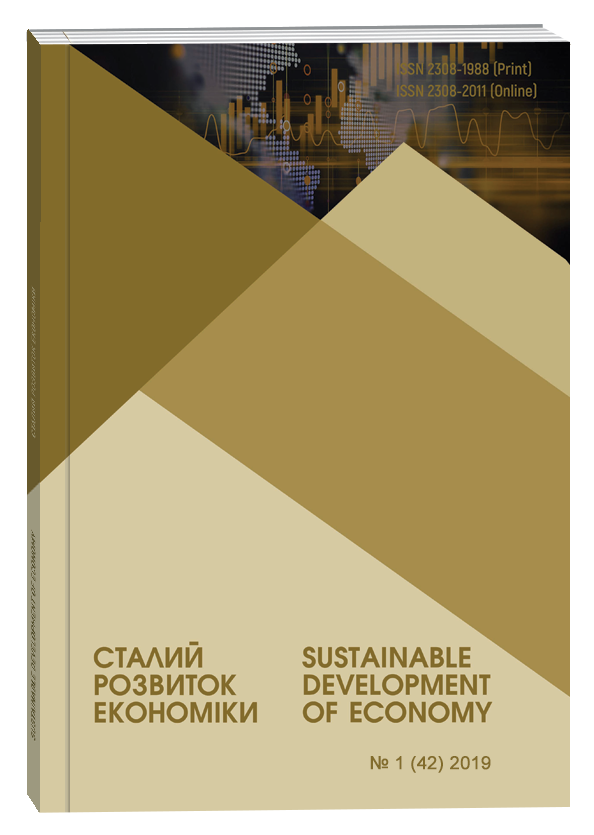CLUSTER APPROACH AS AN EFFICIENT MECHANISM DEVELOPMENT OF PUBLIC-PRIVATE PARTNERSHIP
Abstract
Purpose. The purpose of the article is to use the mechanism of public-private partnership as an instrument for implementing the cluster approach of the investment interests of the state. Methodology of research. The theoretical and methodological basis of the research is the domestic and international normative-legal base, scientific works of domestic scientists concerning the structuring of the category "cluster". To achieve this goal, the following methods were used: general scientific and special research methods: analysis and synthesis - in studying the current state and experience of clusterization in Ukraine; abstract-logical – when drawing conclusions. Findings. The article highlights the features of the application cluster approach to implement investment PPP projects. The authors consider theoretical aspects of the possible development of cluster approach in Ukraine, as well as the role of public-private partnerships in the implementation of this task. Originality. The main factors of the attractiveness of the cluster, which include its components and main factors of attractiveness for participation in the cluster are presented. The transformational decision-making process on the organization and financing of an innovative project based on the mechanism of public-private partnership, which provides economic growth of region with the method of clusterization is substantiated. Practical value. The main provisions of this study can be used in the development of regional clusters, the interaction of authorities, enterprises and industry scientific institutions in the process of cluster formation.
References
Догадайло В.А., Поляткова Е.А. Возможности реализации принципов частно- государственного партнерства в стройиндустрии для развития рынка массового жилищного строительства. Недвижимость и инвестиции. Правовое регулирование. 2009. № 4. С. 58-60. URL: http://dpr.ru/journal/journal_39_16.htm (дата звернення: 20.02.2019).
Грищенко С. Підготовка та реалізація проектів публічно-приватного партнерства: практичний посібник для органів місцевої влади та бізнесу. Київ, 2011. 140 с.
Павлов В.І., Ляхович О.О. Особливості форм державно-приватного партнерства в інноваційній сфері. Регіональна економіка. 2013. № 3(69). С. 57-65.
Портер М. Конкуренция. Москва: Издат. дом «Вильямс»,2005. 608 с.
Цихан Т.В. Кластерная теория экономического развития. Проблемы теории и практики управления. 2003. № 5. URL: http://www.subcontract.ru/docum/documshow_documid_168.html (дата звернення: 21.02.2019).
Вишневская М.К. К вопросу о дефинициях понятия «кластер». Ломоносов: материалы докладов XIV Международной конференции студентов, аспирантов и молодых ученых. Москва: Изд-во МГУ, 2007, C. 39-41. URL: https://lomonosov-msu.ru/archive/Lomonosov_2007/24/vishnevskaya@i.ua.doc.pdf (дата звернення: 21.02.2019).
Кластер как эффективный инструмент социально-экономического развития. URL: www.center-nno.ru/ru/materials/library/13-2 (дата звернення: 22.02.2019).
OECD (2007), Competitive Regional Clusters: National Policy Approaches. URL: www.oecd.org/publications/Policybriefs(дата звернення: 24.02.2019).
Ketels, C. (2013), “Clusters of Innovation in Europe”, in: Structural Change in Europe 3 – Innovative City and Business Regions, Bollschweil: Hagbarth Publications.
Яшева Г. Методологические основы формирования кластерной политики в странах с переходной экономикой. Белорусский экономический журнал.2006. № 2. C. 87-100. URL: http://bseu.by:8080/bitstream/edoc/3826/2/Yasheva_G_Metodologicheskie_osnovy_klasternogo_podkhoda_BEZh_2_06_ocr.pdf (дата звернення: 24.02.2019).
Родионова Л.Н., Хайруллин Р.Ф. Кластеры как форма интеграции инвестиционных ресурсов. Региональная экономика: теория и практика. 2009. № 13 (106). С. 75-80.
Dogadaylo, V.A. and Poliatkova, E.A. (2009), “Opportunities for implementing the principles of public-private partnership in the construction industry for the development of the mass housing market”,
Nedvizhimost I investitsii. Pravovoe regulirovanie, no. 4, рр. 58-60, available at: http://dpr.ru/journal/journal_39_16.htm (access date February 20, 2019).
Hryshchenko, S. (2011), Pidhotovka ta realizatsiiaproektivpublichno-pryvatnohopartnerstva: Praktychnyiposibnykdliaorhanivmistsevoivlady ta biznesu [Training and implementation of projects of publicprivate partnership: Practical textbook for organizations of the government authority and owner], Kyiv, Ukraine, 140 p.
Pavlov, V.I. and Liakhovych, O.O. (2013), “Features of forms of public-private partnership in the innovation sphere”, Rehionalna ekonomika, no. 3(69), pp. 57-65.
Porter, M. (2005),Konkurentsiia [Competition], Izdat. dom «Viliams», Moscow, Russia, 608 p.
Tsikhan, T.V. (2003), “Cluster theory of economic development”, Problemy teorii praktiki upravleniia, no. 5, available at: http://www.subcontract.ru/docum/documshow_documid_168.html (access date February 21, 2019).
Vishnevskaia, M.K. (2007),“On the definition of the concept of "cluster"”, Lomonosov [Lomonosov]: materialy dokladov XIV Mezhdunarodnoy konferentsii studentov, aspirantov I molodykh uchenykh [materials of reports of the XIV International conference of students, postgraduate students and young scientists], Izdvo MGU, Moscow, Russia, pp. 39-41, available at: https://lomonosovmsu.ru/archive/Lomonosov_2007/24/vishnevskaya@i.ua.doc.pdf (access date February 21, 2019).
Klaster kak effektivnyy instrument sotsialno-ekonomicheskogo razvitiia [Cluster as an effective tool for socio-economic development],available at: www.center-nno.ru/ru/materials/library/13-2 (access date February22, 2019).
OECD (2007), Competitive Regional Clusters: National Policy Approaches, available at: www.oecd.org/publications/Policybriefs (access date February 24, 2019).
Ketels, C.(2013), “Clusters of Innovation in Europe”, in: Structural Change in Europe 3 – Innovative City and Business Regions, Hagbarth Publications, Bollschweil, Germany.
Yasheva, G. (2016),“Methodological basis for the formation of cluster policy in countries with economies in transition”, Belorusskiy ekonomicheskiy zhurnal, no. 2, pp. 87-100, available at: http://bseu.by:8080/bitstream/edoc/3826/2/Yasheva_G_Metodologicheskie_osnovy_klasternogo_podkhoda_BEZh_2_06_ocr.pdf (access date February 24, 2019).
Rodionova, L.N. and Khayrullin, R.F. (2009),“Clusters as a form of integration of investment resources”, Regionalnaia ekonomika: teoriia i praktika, no. 13(106), pp. 75-80.


